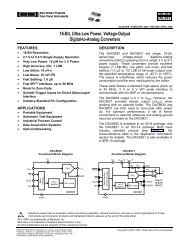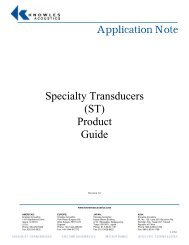AD7714* 3 V/5 V, CMOS, 500 µA Signal Conditioning ADC - dreamm
AD7714* 3 V/5 V, CMOS, 500 µA Signal Conditioning ADC - dreamm
AD7714* 3 V/5 V, CMOS, 500 µA Signal Conditioning ADC - dreamm
Create successful ePaper yourself
Turn your PDF publications into a flip-book with our unique Google optimized e-Paper software.
AD7714<br />
+5V<br />
AV DD<br />
DV DD<br />
THERMOCOUPLE<br />
JUNCTION<br />
AV DD<br />
1µA<br />
CHARGING BALANCING A/D<br />
CONVERTER<br />
AIN2<br />
R C C<br />
AUTO-ZEROED<br />
AIN3<br />
∑∆<br />
PGA<br />
BUFFER<br />
MODULATOR<br />
AIN4<br />
+V IN REGISTER BANK<br />
AIN5<br />
AIN6<br />
A = 1–128<br />
+5V<br />
1µA<br />
SERIAL INTERFACE<br />
AGND<br />
AD780<br />
GND<br />
V OUT<br />
R<br />
AIN1<br />
REF IN (+)<br />
REF IN (–)<br />
AGND<br />
SWITCHING<br />
MATRIX<br />
AD7714<br />
DIGITAL<br />
FILTER<br />
CLOCK<br />
GENERATION<br />
DGND BUFFER DOUT DIN CS SCLK<br />
STANDBY<br />
SYNC<br />
MCLK IN<br />
MCLK OUT<br />
RESET<br />
DRDY<br />
POL<br />
2<br />
DV DD<br />
Figure 13. Thermocouple Measurement Using the AD7714<br />
Figure 14 shows another temperature measurement application<br />
for the AD7714. In this case, the transducer is an RTD (Resistive<br />
Temperature Device), a PT100. The arrangement is a 4-<br />
lead RTD configuration. There are voltage drops across the lead<br />
resistances R L1 and R L4 but these simply shift the commonmode<br />
voltage. There is no voltage drop across lead resistances<br />
R L2 and R L3 as the input current to the AD7714 is very low .<br />
The lead resistances present a small source impedance so it<br />
6.25kΩ<br />
R L1<br />
R L2<br />
RTD<br />
R L3<br />
R L4<br />
400µA<br />
REF IN (+)<br />
REF IN (–)<br />
AIN1<br />
AGND<br />
+5V<br />
AV DD<br />
AV DD<br />
1µA<br />
SWITCHING<br />
MATRIX<br />
AGND<br />
1µA<br />
BUFFER<br />
DV DD<br />
PGA<br />
AIN2 A = 1–128<br />
SERIAL INTERFACE<br />
CHARGING BALANCING A/D<br />
CONVERTER<br />
AUTO-ZEROED<br />
∑∆<br />
MODULATOR<br />
REGISTER BANK<br />
AD7714<br />
DIGITAL<br />
FILTER<br />
CLOCK<br />
GENERATION<br />
STANDBY<br />
SYNC<br />
MCLK IN<br />
MCLK OUT<br />
RESET<br />
DRDY<br />
DGND<br />
BUFFER DOUT DIN CS SCLK<br />
POL<br />
Figure 14. RTD Measurement Using the AD7714<br />
would not generally be necessary to turn on the buffer on the<br />
AD7714. If the buffer is required, the common-mode voltage<br />
should be set accordingly by inserting a small resistance<br />
between the bottom end of the RTD and AGND of the<br />
AD7714. In the application shown an external 400 µA current<br />
source provides the excitation current for the PT100 and it also<br />
generates the reference voltage for the AD7714 via the 6.25 kΩ<br />
resistor. Variations in the excitation current do not affect the<br />
circuit as both the input voltage and the reference voltage vary<br />
ratiometrically with the excitation current. However, the<br />
6.25 kΩ resistor must have a low temperature coefficient to<br />
avoid errors in the reference voltage over temperature.<br />
REV. B –33–















